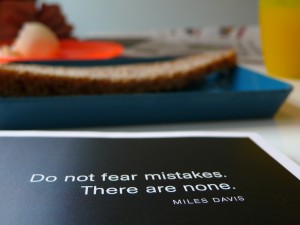 When do you do your best creative thinking? In the shower? During a run? While walking the dog?
When do you do your best creative thinking? In the shower? During a run? While walking the dog?
While you’re sitting at your computer responding to emails and staff walking in and out of your office?
Right, odds are, the latter is not the case, which proves the point that getting away from your desk and your office is key to getting creative thinking done.
Interestingly, a study conducted by University of Pittsburgh and UC Santa Barbara called Lost in the Sauce shows that, according to CBS MoneyWatch, alcohol enhances creative thinking.
They divided the group into two, giving one a vodka/cranberry juice cocktail and the other a placebo.
Those with cocktails found solutions to a word puzzle faster while the others were more focused, but didn’t find the solution as easily or quickly.
If someone were able to find the solution to creative thinking and could bottle it up, they’d of course become very wealthy.
The truth of the matter is, it’s not something that can be outlined in six or eight steps. Also, having a drink isn’t an option for many for a variety of reasons.
Neuroscientists have been trying to crack this nut for a long time. They now think creative thinking isn’t linear. Great ideas come from observations and knowledge of disconnected things. This might explain why having a cocktail which unleashes inhibitions, allows the mind to connect unrelated things, into great ideas. It might be where the whole idea on a cocktail napkin came from.
Most people sell themselves short thinking they aren’t “creative types.” Don’t listen to that voice in your head. There are few original ideas left, but only good curation of ideas. In other words, look for inspiration in other places and industries. Don’t copy, but take good ideas and see how they can be modified to fit your own needs or business model.
Try starting your day off (or whatever time of day works best for you) with a cup of coffee and a notebook, in a quiet room and see what happens. It can be pretty magical.
When do you do your best thinking?
Thanks to Amazing Data for the image.
 Creativity eludes many of us precisely when we need it the most, but as a leader, your job is to be one step ahead and always ready with the next big idea. Creativity is about finding new ways to solve problems and approach situations. It’s not a skill restricted to artists or musicians. It’s a valuable skill for leaders to have, as well.
Creativity eludes many of us precisely when we need it the most, but as a leader, your job is to be one step ahead and always ready with the next big idea. Creativity is about finding new ways to solve problems and approach situations. It’s not a skill restricted to artists or musicians. It’s a valuable skill for leaders to have, as well.
Bruce Nussbaum wrote an article for Fast Company about how to amplify your creativity.
He says, “Creativity is learned behavior that gets better with training--like sports.”
He offers a few ways leaders can boost their creativity.
Learn a new fact, develop a new hobby, and shake things up a bit. Surround yourself with people you find creative or those who your bring creativity out. Take advantage of your “downtime” and use it for activities you normally wouldn’t have time to enjoy.
Consider alternatives to obvious choices. For instance, companies such as Rent the Runway allow customers to rent high fashion goods and it started as alternative to the assumption we have our own wardrobes.
Nussbaum suggests you take a few days - a week or a month - and write down what you do, where you go, and with whom you spend your time. Then map out where and with whom you get your best ideas.
“A creativity map can reveal your process of creativity,” Nussbaum says. Or, it can show the “banality” of your life and why you should change.
Think about how you get things done and reflect on ways your team works together. This will help you be clear about direction. Find the resources you need to take your idea and make it a reality. Don’t gloss over or skip essential steps that would make an innovative idea a reality. Step back; notice where you are in the process and where you need to go next. Be deliberate.
Creativity is learned behavior that gets better with training and experience. It’s about more than just coming up with a great idea. It’s a process with many components and players that make your idea a reality.
Pay attention to the right issues, develop solutions thoughtfully, and implement them. This will help you turn that creative spark into a true breakthrough innovation.
What helps you boost your creativity?
Image courtesy of Stock.xchng
 Some of the most famous and innovative artists in history have had some unusual rituals to get their creative juices flowing.
Some of the most famous and innovative artists in history have had some unusual rituals to get their creative juices flowing.
The idiosyncratic work habits of Beethoven, Kafka, Woody Allen and others are chronicled in a new book, “Daily Rituals: How Artists Work,” written by Mason Currey, and described by Jessica Grose, a contributor to Fast Company.
What’s interesting is how so many of these wildly differing individuals stuck to a routine schedule of work to produce their timeless works of art.
Gertrude Stein, for example, worked only a half-hour each day, while some other writers described in the book labored for a few hours a day. But whatever was going on in their lives, they still worked on their craft at the same time every day.
Creativity demands rigorous focus and energy, which is impossible to maintain without taking a regular break.
Charles Dickens walked as part of his daily routine. Igor Stravinsky (who couldn't compose unless he was certain no one could hear him) did head-stands to “clear the brain” when nothing else worked. Others napped or drank coffee.
“When you step away [from the project] and turn your mind to something else, your mind is still working on it in some way,” Grose says.
Some creative masters learned to fit in their day jobs around the passions that really drove them.
Joseph Heller, an advertising executive by day, wrote the classic 20th century novel, “Catch 22,” for two or three hours each night after coming home from the office. Heller never claimed to be a “tortured artist.” He loved his daily job as much as he did writing “Catch 22.”
Interestingly, many of the artists featured in the book, Daily Rituals, found bathing to be a necessary part of their daily routines.
Writer Somerset Maugham contemplated the first two sentences he planned to write while soaking in the bathtub. Beethoven found it relaxing to stand at the washstand, walk back and forth, return to the washstand and “put water on himself.” This odd ritual led the way to some of his greatest musical compositions, but annoyed neighbors because water kept getting splashed all over the place.
“It’s the repetition that leads you to getting into a creative state,” Grose states. “It’s not the rituals themselves … that lead you into this zone. It’s more that these artists tried to stick with the same pattern every day.”
Patterns and rituals clearly allow our brains time to breathe. And they greatly enhance the creative process. If it worked for Beethoven, it can work for you too.
What daily rituals do you have that get you thinking creatively?
 As a new entrepreneur, you have a great idea for a business. You work hard to build a website to support the business, but you’re careful not to rush into the launch. Some tweaks here, a little adjusting there—you want everything to be perfect before announcing it to the world.
As a new entrepreneur, you have a great idea for a business. You work hard to build a website to support the business, but you’re careful not to rush into the launch. Some tweaks here, a little adjusting there—you want everything to be perfect before announcing it to the world.
According to Alison Johnston Rue, a contributor to The Daily Muse and CEO/co-founder of InstaEDU, an online tutoring company, that’s not the way to go. “It’s the opposite approach—launching something imperfect, getting plenty of feedback, and going through quite a few rounds of trial and error—that will ensure that your company is set up for success.”
Sounds counterintuitive, right?
So do her other nominations for “big mistakes a new entrepreneur makes”—but certainly advice worth considering.
Johnston isn't suggesting you abandon this tried-and-true first step in starting a business, “but you’re wasting your time if you start by drafting a 20-page plan.”
Yes, do your due diligence—including all the appropriate market research and financial analysis—and then find the easiest way to assess how much potential consumer interest there’s likely to be in your future product.
“Without a product that people like,” Johnston notes, “a business plan is pretty useless.
It’s only natural to want to keep your brilliant, once-in-a-lifetime idea to yourself until launch-time.
Why make it easy for someone to steal it?
But there’s a good reason for sharing what you want to do—the process can make your great idea even better.
Getting feedback from other entrepreneurs (as well as “normal people”) can be very helpful, Johnston says. “Discussing your start-up with others will give you greater insight into where there are holes, what does (or doesn't) resonate with people, and the strategies you could use as you’re getting started.”
In other words, someone’s casual reaction to your idea may provide insights into marketing and development that would have never have occurred to you otherwise.
With all the hard work you've put into your new venture, you’re probably convinced as soon as people hear about your product, they’ll knock down the door to be your first customers. Johnston reminds new entrepreneurs “there are thousands of products out there fighting for the attention of your target customers.”
And plenty of would-be customers aren't ready to buy right away. “Most great companies take some time to find their audience.”
Anxious to launch your new business?
Flexibility, creativity, and the willingness to experiment are qualities just as important as the enthusiasm that got you this far in the first place.
What new entrepreneur lessons have you learned about starting a business?
[mc4wp_form]
 Companies that excel at innovation share certain common characteristics.
Companies that excel at innovation share certain common characteristics.
They’re creative, leaders in their markets and have a reputation for being “cutting-edge.”
It’s not surprising most businesses want to join this elite circle.
To do so, says Hal Gregersen and Jeff Dyer, PhDs at the University of California, Irvine, and UCLA respectively, innovation must be “consciously cultivated at the leadership level, and then through the organization.”
As Dyer and Gregersen note in an article for Innovation Management, “If company leaders don’t embrace innovative thinking and skills firsthand, the rest of the organization doesn’t stand a chance.”
According to the authors (co-creators of Innovator’s Accelerator), innovation takes place at three levels, all of which “are important to sustain and grow a business.” These levels include:
(more…)
 What do companies like Kodak, Sears, Sony, and Blockbuster have in common?
What do companies like Kodak, Sears, Sony, and Blockbuster have in common?
All of these once-monolithic businesses clung to status-quo thinking rather than seeking to constantly adapt, innovate, and improve.
In at least two cases, the reward for their conventional thinking was bankruptcy.
How does an organization escape the prison of conventional thinking?
“The first step is to consider the way you have always done business—and stop,” says Brian Klapper, a contributor to the Harvard Business Review Blog. “Failing to do so not only prevents truly innovative thinking: it also ensures failure.”
Klapper, president and founding partner of The Klapper Institute, offers tips for “killing the status quo” in your business strategy. (more…)
